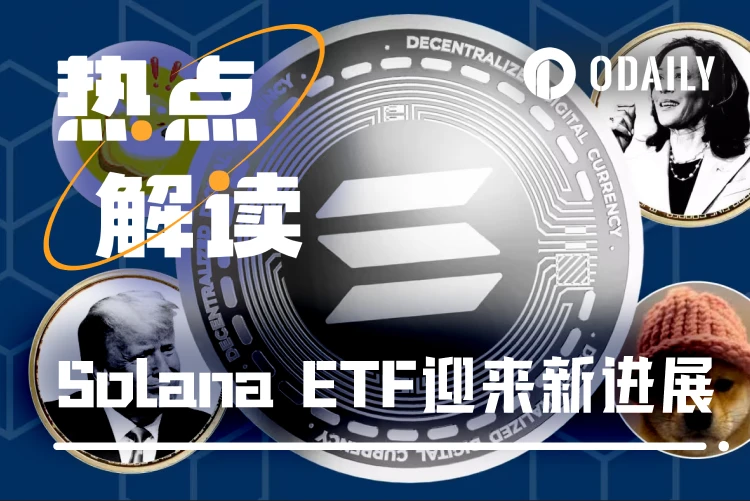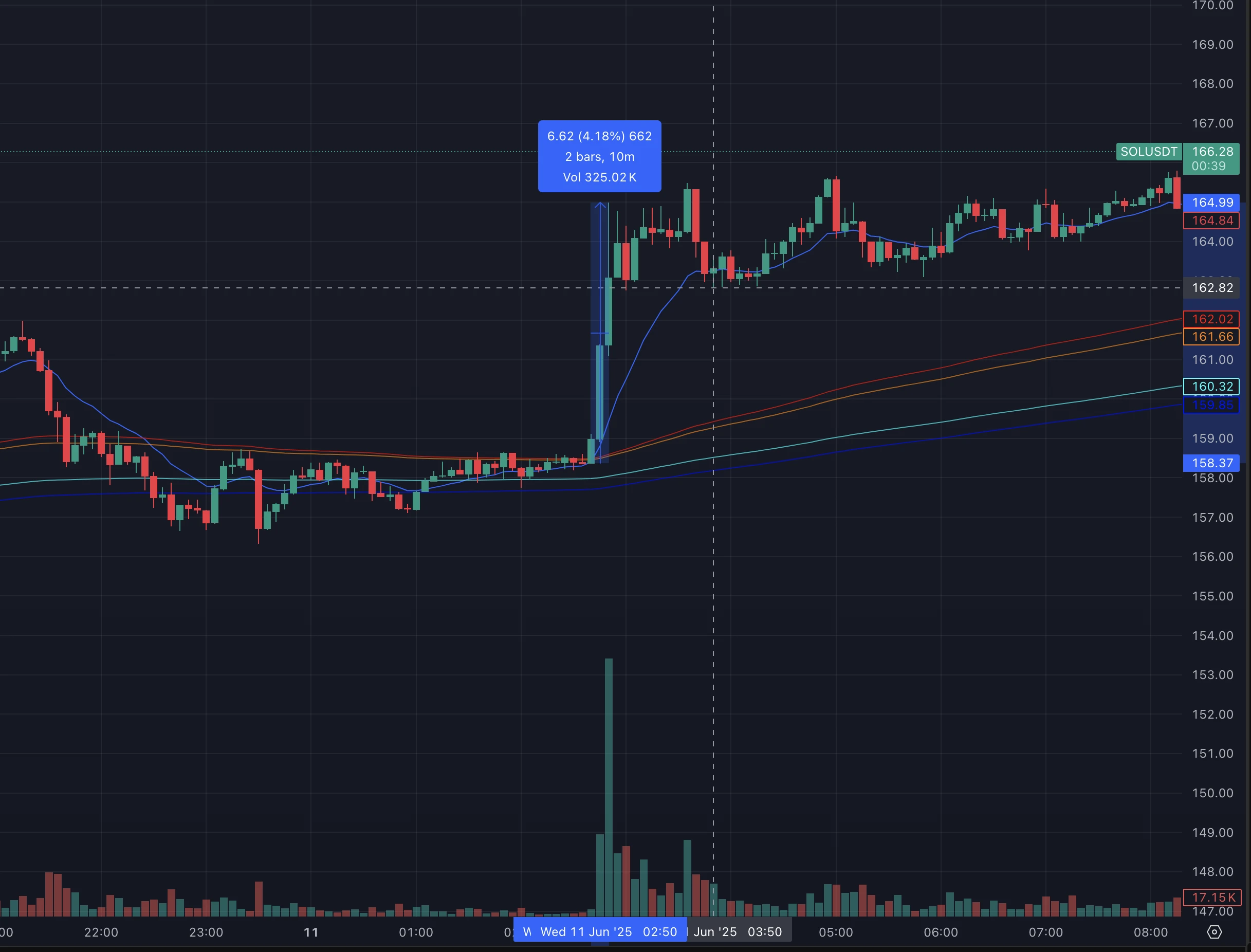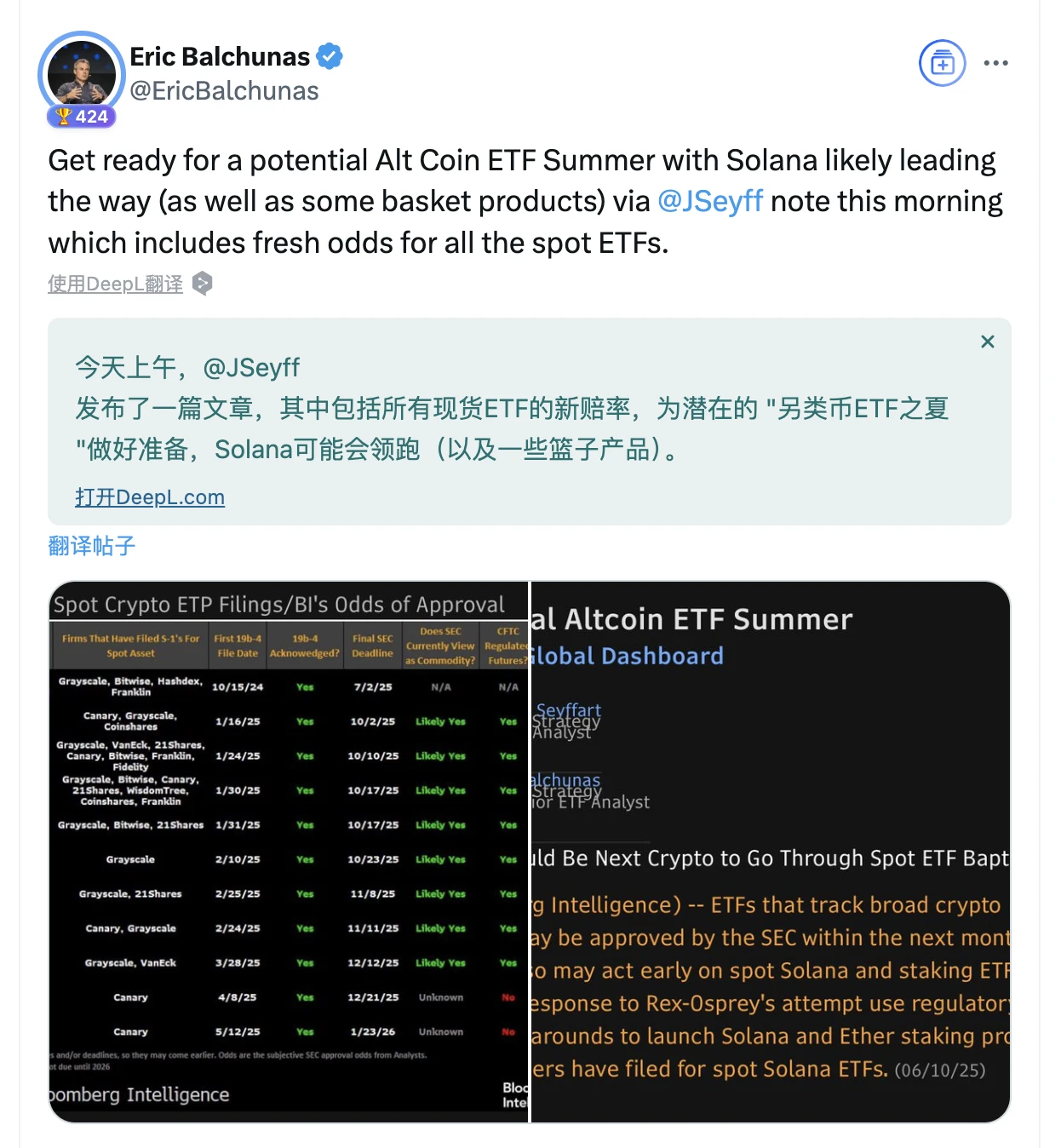Original | Odaily Planet Daily ( @OdailyChina )
Author | Ethan ( @ethanzhang_web3 )

On June 11, the U.S. Securities and Exchange Commission (SEC) issued a notice to several institutions that plan to issue Solana spot ETFs , requiring them to resubmit a revised S-1 filing within 7 days, focusing on the wording revisions to the physical redemption mechanism and pledge clauses.
This move was seen by the market as a clear signal of a change in regulators attitude, and it quickly ignited bullish sentiment. The price of SOL then rose, breaking through $165 in the short term, and the daily increase once reached 5%.
Market sentiment is rapidly heating up, and investors are betting that Solana may become the third crypto asset to be included in spot ETFs by mainstream finance after BTC and ETH. As the ETF trading structure gradually becomes clearer and regulatory signals warm up, investors attention has also shifted from whether it can be passed to when it will be passed and who will launch it.

Regulatory trends: From unimaginable to gradually accepted, Solana enters the review countdown
The current focus of the SEC is no longer whether to allow the Solana spot ETF to go online, but how to legally express the ETFs pledge and redemption structure. To understand why this S-1 revision is so significant, we need to review the SECs past statements on the ETH spot ETF.
On May 24, 2024, the Ethereum spot ETF was approved . The core reason for the approval was that the SEC finally gave up questioning whether ETH was a security, and the ETF structure explicitly excluded the staking clause. This allowed the SEC to regard it as a commodity ETF and incorporate it into the traditional asset regulatory logic.
In contrast, as a highly PoS-dependent chain, the compliance of Solanas staking mechanism has always been a focus of controversy. The SECs request for applicants to clarify the details of the staking mechanism in the S-1 document is widely interpreted as no longer avoiding staking and trying to incorporate PoS logic into the regulatory framework. Staking Rewards data shows that as of June 12, Solanas staking rate was 65.44% and the staking yield was 7.56%, more than twice that of ETH (3.13%).
More importantly, the SEC also promised to complete the review feedback within 30 days after the S-1 document is submitted. This is extremely rare in the previous Bitcoin and Ethereum spot ETF review process, which also means that the landing window of Solana spot ETF has been opened, and it may be approved as early as mid-July.
Approval schedule forecast: SOL ETF will be approved as early as July
According to foreign media Blockworks , sources expect that after completing the updates to these S-1 documents, the Solana ETF is expected to receive final approval within the next three to five weeks.
James Seyffart of Bloomberg Intelligence said he expects approval this year, possibly as early as July. “We believe the SEC may now focus on Solana’s 19 b-4 filing and collateralized ETF earlier than planned,” Seyffart wrote in a report this week. “Issuers and industry participants may have been working with the SEC and its cryptocurrency working group on rulemaking, but the agency’s deadline for a decision on such filings is not until October.”
In April, Bloomberg Industry Research analyst Eric Balchunas said that he had raised the probability of SOL ETF approval from 70% to 90% . In his latest tweet, he said: Get ready for a potential summer of altcoin ETFs, Solana may lead the way (along with some basket products).

In addition, political factors are also quietly driving regulatory shifts: the current US President Trump has publicly supported the crypto industry; both houses of the US Congress have successively passed resolutions to overturn SAB 121, negating the crypto asset accounting policy from a legislative level; the FIT21 bill under review by Congress explicitly proposes to exempt decentralized digital assets from securities standards, and SOL may be above the compliance threshold.
Overall, the approval of the Solana spot ETF has moved from out of reach to the stage of clear path, which also means that it has officially entered the final stage of the compliance game.
Who is lining up? A panoramic view of Solana ETF issuers
Competition for the Solana ETF began with VanEck’s S-1 filing last year , followed by 21 Shares and Bitwise .
Currently , seven asset management companies, including VanEck, 21 Shares, Grayscale, Bitwise, Canary Capital, Franklin Templeton, and Fidelity, have submitted applications for Solana ETFs. They are waiting for the SEC’s final decision on their Solana ETF applications. Among them, Grayscale is planning to replicate and convert its existing SOL trust products into spot ETFs due to its successful cases in BTC and ETH spot ETFs.

Image source: @Shibo
With the approval of ETF, can SOL take off like BTC?
Lessons from BTC ETFs:
Refer to the market reaction before and after the approval of the BTC spot ETF from the end of 2023 to the beginning of 2024: BTC started at around US$27,000 in October 2023, and fell 15% in a short period of time on the day its spot ETF began trading and the next day (January 11-12, 2024) , and then fell 21% in total , and then began to soar all the way to a high of US$73,000, an increase of nearly 2.7 times.

However, such a good wish did not come true for ETH. Since ETH confirmed the spot ETF in May, until the ETF was opened for trading on July 23, the price of ETH has been flat, with an increase of less than 30%. One month after the ETF was opened for trading, it plummeted by more than 30%.
Although the approval of ETFs has positive implications for the long-term legitimacy of cryptocurrencies and institutional capital inflows, short-term price performance is affected by market expectations and the psychology of buy expectations and sell facts. Therefore, for ETH, the approval of its ETF may be more of a verification of the markets previous expectations rather than a new stimulus that is not factored into the price. Another reason is that ETHs ETF is a castrated version without a staking income mechanism, which is also not very attractive to users.
How much upside could SOL have if it were to go through an ETF?
According to the GSR model , if the capital inflow of SOL ETF is 5% of that of BTC ETF, its increase may reach 3.4 times based on market value, that is, from the current US$160 to US$500, and may hit the US$400-500 range; in a more optimistic scenario, if the capital inflow accounts for 14%, the price may reach more than US$800.
However, it is worth noting that SOL has a risk of selling pressure. The cost for early investors of SOL is extremely low, and the landing of ETF may become a node for unlocking exit. In addition, the supply structure of SOL is different from that of BTC and ETH: the pledge ratio has exceeded 65%, and whether ETFs allow shares to be pledged is still uncertain . Once the pledge income is not included in the ETF structure, SOL in the spot ETF will lose its attractiveness due to not participating in the on-chain returns. In addition, once ETFs become mainstream funding channels, on-chain DEX and DeFi ecosystems may encounter liquidity migration risks .
Therefore, before and after the ETF news is confirmed, the market is likely to continue to experience the fluctuation structure of first speculation on expectations, then realization, which is very similar to the price cycle before and after the BTC ETF starts trading.
Is SOL worth investing heavily?
Judging from the current public information and market feedback, the Solana spot ETF is expected to be officially approved within the next 2 to 3 weeks, becoming another mainstream entry channel after BTC and ETH.
In the short term, SOL prices may be further driven by capital expectations and hit the $200-300 range; in the medium term, whether it can repeat the BTC-style outbreak requires attention to two variables:
Can the ETF structure design solve the pledge problem and truly achieve the dual goals of on-chain returns + regulatory transparency?
Whether the on-chain ecosystem can take on the new traffic and transaction demands and build a stable capital + application closed loop.
At the node where crypto assets are moving towards compliance and mainstream finance, Solana ETF is not only a product, but also a collective stress test for public chain competition, PoS consensus mechanism and DeFi applications.










